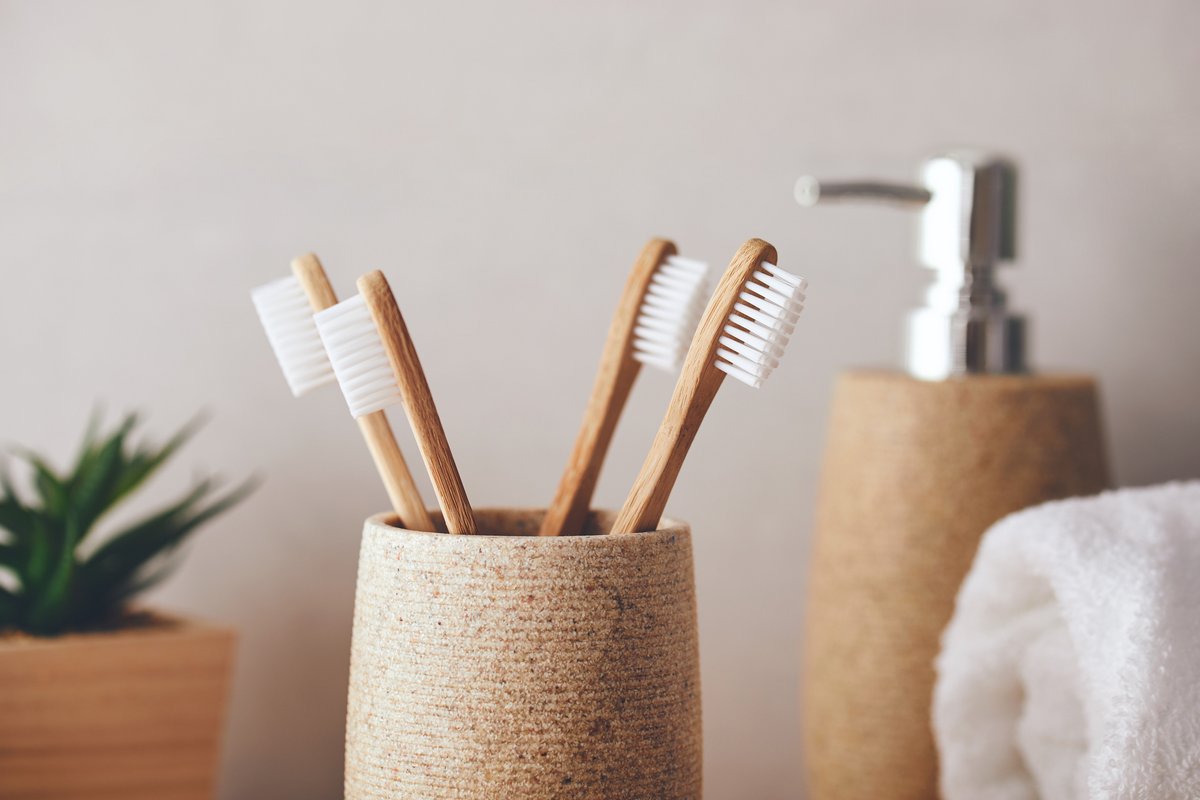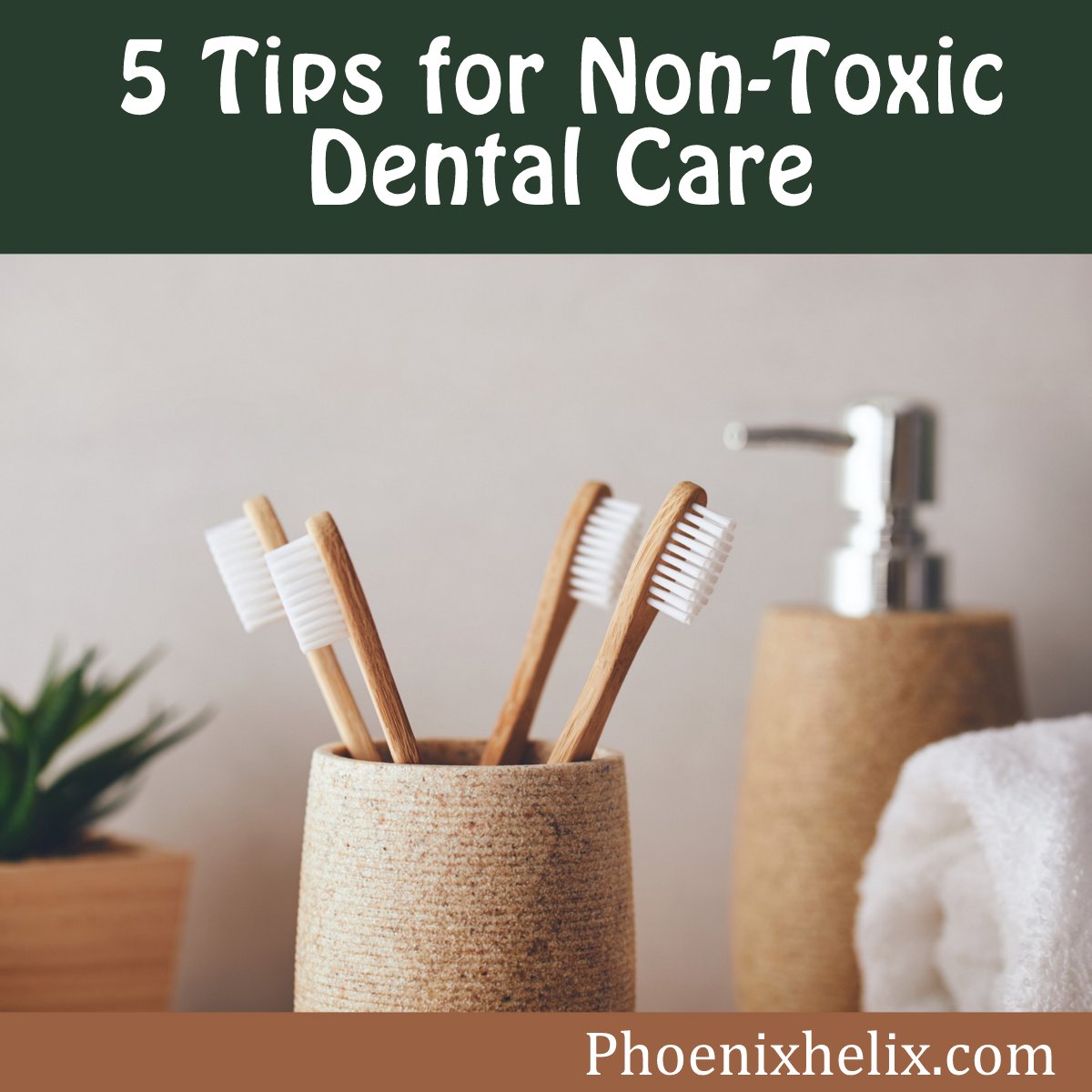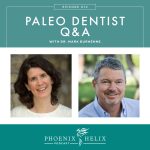
“A warm smile is the universal language of kindness.”
~ William Arthur Ward
1. Is There Teflon In Your Dental Floss?
My favorite dental floss for years was the “glide” style of floss. I loved how comfortable it was and never stopped to question what made it so smooth. When I started researching non-toxic living, it made sense to look at my dental care routine. I was in for a surprise! PFAS is a group of chemicals with non-stick properties. It’s used in Teflon pans, food packaging, and many brands of glide-style floss. Unfortunately, these chemicals are linked to harmful health consequences, including effects on the immune system. A study published in 2019 found that women who used glide flosses had higher rates of PFAS in their bloodstream than those who didn’t. I had already removed Teflon pans from my kitchen. It was time to remove it from my floss as well.
The floss fell in love with is Dr. Tung’s Smart Floss. It’s a woven fiber floss that contains no PFAS or petrochemical waxes. Instead, it’s naturally coated in a vegetable/beeswax blend, with a small amount of natural cardamom oil. It’s also designed to be an “expansive floss”. It’s thicker than most styles of floss, but it compresses to get into the small gaps between teeth, and then expands to grab more plaque on the way out. It’s actually easy to use, gentle on the gums, and more effective at removing plaque. It’s the best floss I’ve ever tried.
Another brand similar in style is Cocofloss. It’s also an “expansive floss”, but it’s infused with coconut oil for its antimicrobial properties and uses a vegan wax (no beeswax). Unfortunately, one of their selling points is fragrance, and they add synthetic fragrance to most of their options. Mint is their only floss with natural fragrance. It’s a blend of spearmint oil, cornmint oil, anise camphor, and menthol.
Both of the flosses above are made from polyester fibers, because they’re stronger and more effective at removing plaque without breaking. If you want a 100% natural product, you can try Dental Lace. It’s a silk floss, coated in vegan wax, and scented with organic peppermint essential oil. Its selling point is that its a zero-waste product, but reviews are mixed on its strength and effectiveness.
2. What’s the Best Toothbrush: Electric or Manual?
Electric toothbrushes have become more popular, and they’re often advertised as doing a better job at removing plaque. Research supports this claim, but not by a large amount (about 10%), and there’s a downside. Electric toothbrushes cause more dentin loss than manual toothbrushes. Dentin is one of the four main components of our teeth and vital to tooth health.
Upon the advice of my dental hygienist, I tried a high-quality, sonic electric toothbrush. It led to a fractured tooth, even though I was using the gentlest setting. I’m over 50 years old, and I have some old fillings. Microfractures are common in the surrounding tooth structure. My dentist had been aware of this for years, but my teeth had been stable. The electric vibrations expanded those microfractures, and I ended up needing a crown. Although I would likely have needed a crown eventually, this definitely sped up the process. Needless to say, I’m not a fan of electric toothbrushes.
It’s also possible that the reason electric toothbrushes show greater plaque reduction is simply that people use them longer. Most include a two minute brushing timer. If you do that with a regular toothbrush, you are likely to get the same result. Research shows that brushing your teeth for two minutes removes twice as much plaque as brushing for one minute.
My favorite toothbrush is the RADIUS Source Toothbrush. It’s a sustainable design. The handle is made from repurposed materials, and it features a replaceable head which reduces waste. The handle is also ergonomically designed and is reversible for right or left-handed people. Lastly, it has a uniquely shaped head that reaches more tooth area while still being gentle on the gums.
Bamboo toothbrushes are also popular because they’re made from sustainable materials and you can compost the handle. But their bristles are nylon, so you do need to remove them before composting. Also, remember that bamboo can mold, so it requires a little more care. Resource: How to Care for a Bamboo Toothbrush.
3. Choosing a Toothpaste or Toothpowder
The first question is whether toothpaste is even necessary. Simply brushing with a wet toothbrush will clean your teeth to a certain degree, but toothpaste and powder are even more effective. They add a texture that breaks up the biofilm that turns into plaque. The problem is that many conventional toothpastes contain harmful ingredients as well.
Harmful Ingredients to Avoid:
- Triclosan – is an antimicrobial that the FDA banned from hand soap but still allows in toothpaste. It’s known to have multiple harmful effects including inflammation, immune system dysregulation, and hormone disruption.
- Sodium lauryl sulfate – is a foaming agent that disrupts the oral microbiome and can cause canker sores.
- Artificial coloring – is connected to many health conditions and is potentially carcinogenic and genotoxic.
- Titanium dioxide – makes toothpaste white. It contains nanoparticles that are absorbed into the body and can change gene expression.
- Hydrated silica – is an abrasive. Gentle abrasives like baking soda can be beneficial, but strong abrasives like silica can damage teeth.
- Activated charcoal – is added as a teeth whitener, but research shows it’s not effective and can also damage teeth.
- Parabens – are preservatives known to be hormone disruptors.
What About Fluoride?
- Research shows that fluoride toothpaste does help prevent cavities, but it’s most effective at high concentrations. Since there are dangers associated with fluoride as well, many natural dentists believe it’s not worth the risk. However, toothpaste isn’t the biggest area of concern. Fluoridated water is a higher risk because of the quantity of water we drink. Filtering water eliminates this risk.
Four Recommendations:
- The simplest choice is baking soda, and I used that for years. Research shows that it’s effective at biofilm removal without damaging teeth. It reduces harmful bacteria without disrupting beneficial bacteria. It reduces gum inflammation and supports tooth remineralization. That must be why actress Julia Roberts swears by it, with her famous smile.
- Another great choice is Primal Life Organics Toothpowder. It adds three types of clay to the baking soda, to support remineralization of the teeth. The only other ingredient is pure essential oil. (I don’t recommend the black toothpowders that contain charcoal, because it can damage teeth.)
- It’s hard to find a toothpaste with none of the harmful ingredients listed above. Even the natural ones usually include strong abrasives. The purest one I’ve found is Redmond Earthpaste.
- You can also make your own toothpaste. Here’s a recipe from Dr. Mark Burhenne (aka The Paleo Dentist). It’s a probiotic toothpaste meant to support your oral microbiome and dental health at the same time. Note: to make it strict AIP, skip the cacao and xylitol, but if you’re through the elimination phase, you can try this as a reintroduction. Pure cacao in a toothpaste has dental health benefits, and xylitol does as well.
4. Oil Pulling: Yay or Nay?
Oil pulling is a traditional ayurvedic remedy originally practiced in India as a natural form of dental care. It’s the act of swishing oil around your mouth to cleanse and nourish your teeth, gums, and oral tissue. It’s called oil pulling, because it pulls out impurities. The oils most commonly used are coconut oil, sesame oil, olive oil, or sunflower oil. Coconut oil has the added benefit of being anti-microbial.
So, what does the research say? Studies show that oil pulling reduces plaque and gingivitis, and anecdotal evidence supports those findings. I love posting polls on my Facebook page, and many people in my community have tried oil pulling. While it doesn’t help everyone, some people have experienced measurable changes that are affirmed by their dentist: less tartar, healthier gums, fresher breath, less tooth sensitivity, whiter teeth, and fewer cavities. And one person with Sjogren’s syndrome said it moisturizes her mouth and makes her oral tissue healthier. (Dry mouth is a symptom of Sjogren’s and can lead to dental health problems).
If you’d like to give it a try, here’s a tutorial. One final note: it doesn’t replace the need for toothbrushing or flossing. It works best in combination with a complete dental health routine.
5. Nutrition for Healthy Teeth
What can we do to support dental health from the inside out?
It won’t surprise anyone to know that sugar is linked to cavities. That’s knowledge that most of us heard as children. Why is this so? Sugar feeds the bacteria that naturally exists in our mouth, and the byproduct is acid. It’s the acid that breaks down the tooth enamel, creating decay. One tip is to rinse your mouth after eating something sweet or acidic. (Some examples of acidic foods/drinks are citrus, coffee, tea, vinegar, and kombucha.) It doesn’t mean we can rinse away a high-sugar diet, but we can give our teeth a “bath” after the occasional indulgence.
However, a healing diet isn’t just about foods to avoid. It’s also about the foods we choose to eat. Nutrient deficiencies affect our health on every level, including our teeth. Here’s a list of some nutrients that are especially beneficial to dental health:
- Vitamin A – a deficiency can interfere with tooth development and remineralization. It’s also linked to periodontitis (infection of the gums). Food sources include: liver, eggs, and seafood.
- Vitamin D – works synergistically with vitamin A, so a vitamin D deficiency is linked to the same problems mentioned above. It’s difficult to get enough vitamin D through food, but sources include oily fish, mushrooms, liver, and eggs. Sunshine is the best source, and under a doctor’s guidance, supplementation is sometimes beneficial.
- Vitamin C – a deficiency causes changes in both the teeth and gums and can also cause dry mouth. Food sources include: dark leafy greens, broccoli, Brussels sprouts, citrus fruits, and berries.
- B Vitamins – deficiencies can cause problems with the entire mouth – the teeth, gums, and oral cavity. Canker sores have been linked to these deficiencies as have rashes surrounding the mouth. Food sources include: meat (especially organ meat), fish, eggs, nuts, seeds, dark leafy vegetables, citrus, and avocados.
- Minerals: calcium, phosphorous, and magnesium are all essential to proper tooth formation and deficiencies are linked to cavities. Food sources of calcium include: green leafy vegetables, sardines (when you eat the bones), and grass-fed dairy (if tolerated). High-protein foods like meat and seafood are excellent sources of phosphorous. Magnesium is difficult to get through diet alone, so supplementation is often helpful, but food sources include: green vegetables, fish, nuts, seeds, dark chocolate, bananas, and avocados.
- Research Studies: Vitamins in Oral Health and Minerals in Oral Health.
You May Also Be Interested In
Credit: image at top of page purchased from iStock.









I use Dr Tungs dental floss and love it. I also have been using Uncle Harry’s anise toothpaste
https://www.uncleharrys.com/anise-toothpaste-3-oz-glass-jar
He makes a lot of wonderful products arising from the ayervedic tradition.
Hi Debbie. Thanks for sharing what’s working for you. Here’s to great dental health!